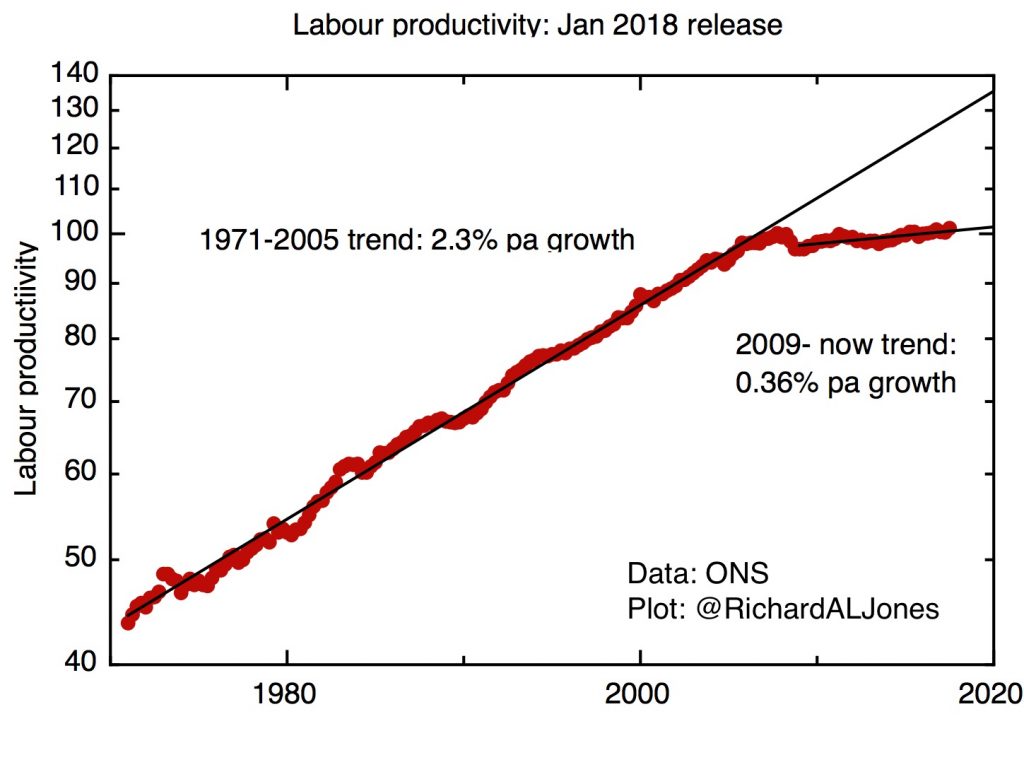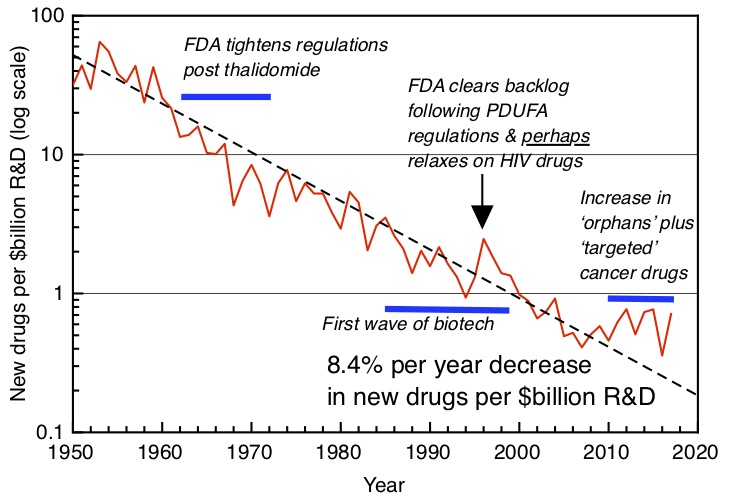In my last post, I discussed how “econophysics” has been criticised for focusing on exchange, not production – in effect, for not concerning itself with the roots of economic growth in technological innovation. Of course, some of that technological innovation has arisen from physics itself – so here I talk about what economic growth theory might learn from an important episode of technological innovation with its origins in physics – the development of the semiconductor industry.
Economic growth and technological innovation
In my last post, I criticised econophysics for not talking enough about economic growth – but to be fair, it’s not just econophysics that suffers from this problem – mainstream economics doesn’t have a satisfactory theory of economic growth either. And yet economic growth and technological innovation provides an all-pervasive background to our personal economic experience. We expect to be better off than our parents, who were themselves better off than our grandparents. Economics without a theory of growth and innovation is like physics without an arrow of time – a marvellous intellectual construction that misses the most fundamental observation of our lived experience.
Defenders of economics at this point will object that it does have theories of growth, and there are even some excellent textbooks on the subject [1]. Moreover, they might remind us, wasn’t the Nobel Prize for economics awarded this year to Paul Romer, precisely for his contribution to theories of economic growth? This is indeed so. The mainstream approach to economic growth pioneered by Robert Solow regarded technological innovation as something externally imposed, and Romer’s contribution has been to devise a picture of growth in which technological innovation arises naturally from the economic models – the “post-neoclassical endogenous growth theory” that ex-Prime Minister Gordon Brown was so (unfairly) lampooned for invoking.
This body of work has undoubtedly highlighted some very useful concepts, stressing the non-rivalrous nature of ideas and the economic basis for investments in R&D, especially for the day-to-day business of incremental innovation. But it is not a theory in the sense a physicist might understand that – it doesn’t explain past economic growth, so it can’t make predictions about the future.
How the information technology revolution really happened
Perhaps to understand economic growth we need to turn to physics again – this time, to the economic consequences of the innovations that physics provides. Few would disagree that a – perhaps the – major driver of technological innovation, and thus economic growth, over the last fifty years has been the huge progress in information technology, with the exponential growth in the availability of computing power that is summed up by Moore’s law.
The modern era of information technology rests on the solid-state transistor, which was invented by William Shockley at Bell Labs in the late 1940’s (with Brattain and Bardeen – the three received the 1956 Nobel Prize for Physics). In 1956 Shockley left Bell Labs and went to Palo Alto (in what would later be called Silicon Valley) to found a company to commercialise solid-state electronics. However, his key employees in this venture soon left – essentially because he was, by all accounts, a horrible human being – and founded Fairchild Semiconductors in 1957. Key figures amongst those refugees were Gordon Moore – of eponymous law fame – and Robert Noyce. It was Noyce who, in 1960, made the next breakthrough, inventing the silicon integrated circuit, in which a number of transistors and other circuit elements were combined on a single slab of silicon to make a integrated functional device. Jack Kilby, at Texas Instruments, had, more or less at the same time, independently developed an integrated circuit on germanium, for which he was awarded the 2000 Physics Nobel prize (Noyce, having died in 1990, was unable to share this). Integrated circuits didn’t take off immediately, but according to Kilby it was their use in the Apollo mission and the Minuteman ICBM programme that provided a turning point in their acceptance and widespread use[2] – the Minuteman II guidance and control system was the first mass produced computer to rely on integrated circuits.
Moore and Noyce founded the electronics company Intel in 1968, to focus on developing integrated circuits. Moore had already, in 1965, formulated his famous law about the exponential growth with time of the number of transistors per integrated circuit. The next step was to incorporate all the elements of a computer on a single integrated circuit – a single piece of silicon. Intel duly produced the first commercially available microprocessor – the 4004 – in 1971, though this had been (possibly) anticipated by the earlier microprocessor that formed the flight control computer for the F14 Tomcat fighter aircraft. From these origins emerged the microprocessor revolution and personal computers, with its giant wave of derivative innovations, leading up to the current focus on machine learning and AI.
Lessons from Moore’s law for growth economics
What should clear from this very brief account is that classical theories of economic growth cannot account for this wave of innovation. The motivations that drove it were not economic – they arose from a powerful state with enormous resources at its disposal pursuing complex, but entirely non-economic projects – such as the goal of being able to land a nuclear weapon on any point of the earth’s surface with an accuracy of a few hundred meters.
Endogenous growth theories perhaps can give us some insight into the decisions companies made about R&D investment and the wider spillovers that such spending led to. They would need to take account of the complex institutional landscape that gave rise to this innovation. This isn’t simply a distinction between public and private sectors – the original discovery of the transistor was made at Bell Labs – nominally in the private sector, but sustained by monopoly rents arising from government action.
The landscape in which this innovation took place seems much more complex than growth economics, with its array of firms employing undifferentiated labour, capital, all benefiting from some kind of soup of spillovers seems able to handle. Semiconductor fabs are perhaps the most capital intensive plants in the world, with just a handful of bunny-suited individuals tending a clean-room full of machines that individually might be worth tens or even hundreds of millions of dollars. Yet the value of those machines represents, as much as anything physical, the embodied value of the intangible investments in R&D and process know-how.
How are the complex networks of equipment and materials manufacturers coordinated to make sure technological advances in different parts of this system happen at the right time and in the right sequence? These are independent companies operating in a market – but the market alone has not been sufficient to transmit the information needed to keep it coordinated. An enormously important mechanism for this coordination has been the National Technology Roadmap for Semiconductors (later the International Technology Roadmap for Semiconductors), initiated by a US trade body, the Semiconductor Industry Association. This was an important social innovation which allowed companies to compete in meeting collaborative goals; it was supported by the US government by the relaxation of anti-trust law and the foundation of a federally funded organisation to support “pre-competitive” research – SEMATECH.
The involvement of the US government reflected the importance of the idea of competition between nation states in driving technological innovation. Because of the cold war origins of the integrated circuits, the original competition was with the Soviet Union, which created an industry to produce ICs for military use, based around Zelenograd. The degree to which this industry was driven by indigenous innovation as against the acquisition of equipment and know-how from the west isn’t clear to me, but it seems that by the early 1980’s the gap between Soviet and US achievements was widening, contributing to the sense of stagnation of the later Brezhnev years and the drive for economic reform under Gorbachev.
From the 1980’s, the key competitor was Japan, whose electronics industry had been built up in the 1960’s and 70’s driven not by defense, but by consumer products such as transistor radios, calculators and video recorders. In the mid-1970’s the Japanese government’s MITI provided substantial R&D subsidies to support the development of integrated circuits, and by the late 1980’s Japan appeared within sight of achieving dominance, to the dismay of many commentators in the USA.
That didn’t happen, and Intel still remains at the technological frontier. Its main rivals now are Korea’s Samsung and Taiwan’s TSMC. Their success reflects different versions of the East Asian developmental state model; Samsung is Korea’s biggest industrial conglomerate (or chaebol), whose involvement in electronics was heavily sponsored by its government. TSMC was a spin-out from a state-run research institute in Taiwan, ITRI, which grew by licensing US technology and then very effectively driving process improvements.
Could one build an economic theory that encompasses all this complexity? For me, the most coherent account has been Bill Janeway’s description of the way government investment combines with the bubble dynamics that drives venture capitalism, in his book “Doing Capitalism in the Innovation Economy”. Of course, the idea that financial bubbles are important for driving innovation is not new – that’s how the UK got a railway network, after all – but the econophysicist Didier Sornette has extended this to introduce the idea of a “social bubble” driving innovation[3].
This long story suggests that the ambition of economics to “endogenise” innovation is a bad idea, because history tells us that the motivations for some of the most significant innovations weren’t economic. To understand innovation in the past, we don’t just need economics, we need to understand politics, history, sociology … and perhaps even natural science and engineering. The corollary of this is that devising policy solely on the basis of our current theories of economic growth is likely to lead to disappointing outcomes. At a time when the remarkable half-century of exponential growth in computing power seems to be coming to an end, it’s more important than ever to learn the right lessons from history.
[1] I’ve found “Introduction to Modern Economic Growth”, by Daron Acemoglu, particularly useful
[2] Jack Kilby: Nobel Prize lecture, https://www.nobelprize.org/uploads/2018/06/kilby-lecture.pdf
[3] See also that great authority, The Onion “Recession-Plagued Nation Demands New Bubble to Invest In”

